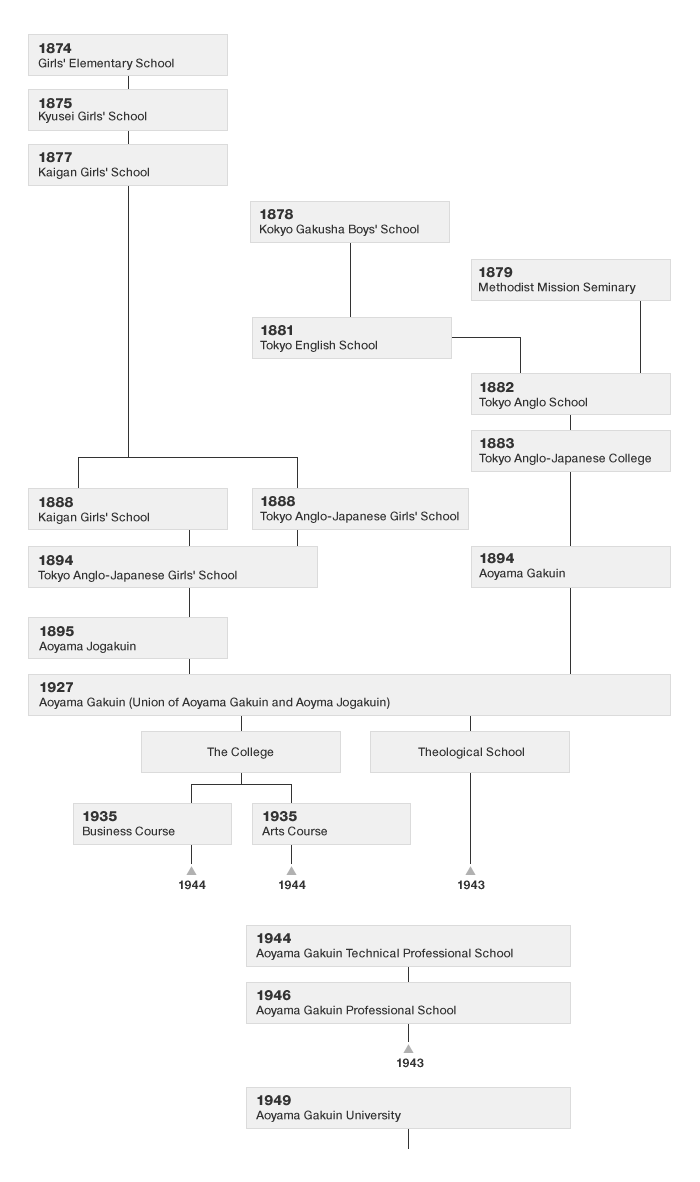- MENU -
Origins 1874
The origin of Aoyama Gakuin University dates back to 1874 when Dora E. Schoonmaker, the first single female missionary in Japan from the Woman's Foreign Missionary Society of the Methodist Episcopal Church, founded a girls’ school in Tokyo. The centuries-old edict against Christianity in Japan had been lifted just a year earlier. In the following years, two other boys’ schools were founded by missionaries Julius Soper and Robert S. Maclay, respectively. These three Methodist schools evolved into the present-day Aoyama Gakuin.
Aoyama Campus
Aoyama Gakuin moved to its current site at Aoyama, Shibuya in 1882. The school acquired the 30,000 square-meter land, originally a lord’s manner house, thanks to 5,000 USD donated by John F. Goucher, an American Methodist pastor who was determined to establish a Methodist university in Tokyo. The letters sent by then-Aoyama missionaries to the US headquarters show their admiration for the site; “The situation is one of the best in Tokio (sic)”,”Awayama (sic) is most desirable.”
Challenges make Aoyama Gakuin Stronger
Through its 150-year journey, Aoyama Gakuin has strengthened its fundamental mission of public service by overcoming various challenges.
The first of these challenges was in 1899 when a reaction to excessive Westernization and the rise of nationalism led the government to ban religious education. Despite protesting, Aoyama Gakuin was disqualified and many students left. Faculties and students who stayed, however, did not give in. With the arrival of the 1903 educational reform, Aoyama Gakuin not only reclaimed its qualification but also expanded itself by launching new facilities including a theological school.
The Great Kanto Earthquake of 1923 collapsed most of the school buildings. Aoyama Gakuin was united in helping the local community; surviving buildings had been loaned for use as hospitals and Aoyama Gakuin welcomed Korean refugees whose lives had been threatened by racial hatred. During the reconstruction, the foundation of the current campus was laid out, which included the main avenue lined with ginkgo trees.
In 1941, just before the Pacific War, American missionaries were recalled back home. Aoyama Gakuin was also forced to compromise its school motto in order to accommodate a more nationalistic leaning. Male students were sent to the battlefield while female students were mobilized to support the war effort. The Great Tokyo Air Raid of May 25, 1945 destroyed seventy per cent of Aoyama Gakuin’s buildings.
New AGU and New Millennium
Aoyama Gakuin vigorously emerged from the ruins of World War II. Aoyama Gakuin University found its new life under the post-war school education reforms, with undergraduate colleges in literature, commerce and engineering. The establishment of colleges in such disciplines as law, science and engineering followed. In the ever globalizing world of the 1980s the Faculty of International Politics and Economics was introduced while in the 2000s the increasing stress on creativity and IT led AGU to include colleges in such fields as Cultural and Creative Studies, and Social Informatics.
Today, initiatives such as Aoyama Vision 2024 are being established; the goals include making AGU an international research hub and exploring the role of humanities in the Information Age. With its aim of ranking among the top universities in the world, AGU continues to work hard to foster talented and creative thinkers who, with public service in mind, can help lead society towards a better future.
Chronological Table
